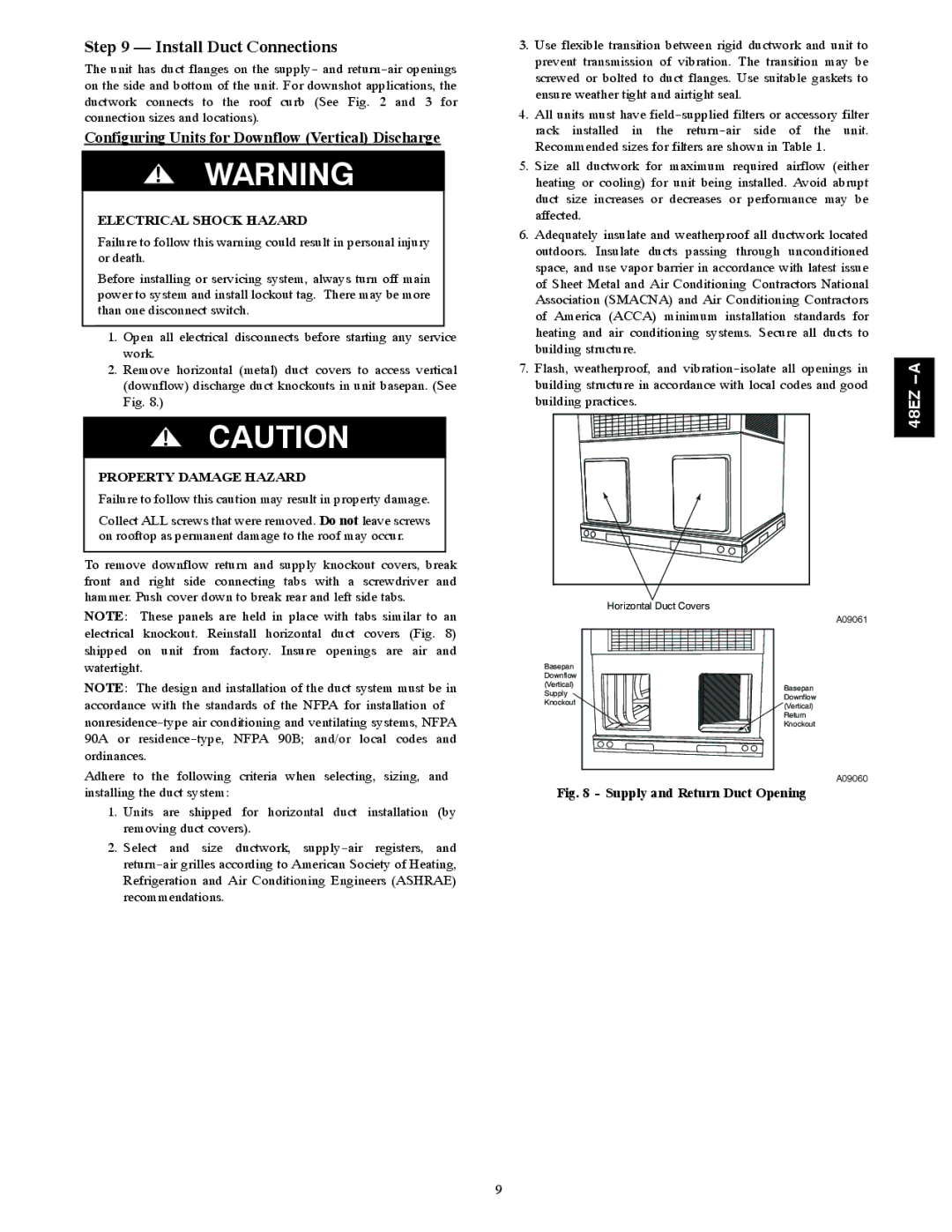
Step 9 — Install Duct Connections
The unit has duct flanges on the supply- and
Configuring Units for Downflow (Vertical) Discharge
!WARNING
ELECTRICAL SHOCK HAZARD
Failure to follow this warning could result in personal injury or death.
Before installing or servicing system, always turn off main power to system and install lockout tag. There may be more than one disconnect switch.
1.Open all electrical disconnects before starting any service work.
2.Remove horizontal (metal) duct covers to access vertical (downflow) discharge duct knockouts in unit basepan. (See Fig. 8.)
!CAUTION
PROPERTY DAMAGE HAZARD
Failure to follow this caution may result in property damage.
Collect ALL screws that were removed. Do not leave screws on rooftop as permanent damage to the roof may occur.
To remove downflow return and supply knockout covers, break front and right side connecting tabs with a screwdriver and hammer. Push cover down to break rear and left side tabs.
3. | Use flexible transition between rigid ductwork and unit to |
| |||||||||||||||||||
| prevent transmission of vibration. The transition may be |
| |||||||||||||||||||
| screwed or bolted to duct flanges. Use suitable gaskets to |
| |||||||||||||||||||
| ensure weather tight and airtight seal. |
| |||||||||||||||||||
4. | All units must have |
| |||||||||||||||||||
| rack installed in the |
| |||||||||||||||||||
| Recommended sizes for filters are shown in Table 1. |
| |||||||||||||||||||
5. | Size all ductwork for maximum required airflow (either |
| |||||||||||||||||||
| heating or cooling) for unit being installed. Avoid abrupt |
| |||||||||||||||||||
| duct size increases or decreases or performance may be |
| |||||||||||||||||||
| affected. |
| |||||||||||||||||||
6. | Adequately insulate and weatherproof all ductwork located |
| |||||||||||||||||||
| outdoors. Insulate ducts passing through unconditioned |
| |||||||||||||||||||
| space, and use vapor barrier in accordance with latest issue |
| |||||||||||||||||||
| of Sheet Metal and Air Conditioning Contractors National |
| |||||||||||||||||||
| Association (SMACNA) and Air Conditioning Contractors |
| |||||||||||||||||||
| of America (ACCA) minimum installation standards for |
| |||||||||||||||||||
| heating and air conditioning systems. Secure all ducts to |
| |||||||||||||||||||
| building structure. |
| |||||||||||||||||||
7. | Flash, weatherproof, and | A | |||||||||||||||||||
| building structure in accordance with local codes and good | ||||||||||||||||||||
| 48EZ | ||||||||||||||||||||
| building practices. | ||||||||||||||||||||
|
| ||||||||||||||||||||
|
|
|
|
|
|
|
|
|
|
|
|
|
|
|
|
|
|
|
|
|
|
|
|
|
|
|
|
|
|
|
|
|
|
|
|
|
|
|
|
|
|
|
|
|
|
|
|
|
|
|
|
|
|
|
|
|
|
|
|
|
|
|
|
|
|
NOTE: These panels are held in place with tabs similar to an electrical knockout. Reinstall horizontal duct covers (Fig. 8) shipped on unit from factory. Insure openings are air and watertight.
NOTE: The design and installation of the duct system must be in accordance with the standards of the NFPA for installation of
Horizontal Duct Covers
Basepan Downflow (Vertical) Supply Knockout
A09061
Basepan Downflow (Vertical) Return Knockout
Adhere to the following criteria when selecting, sizing, and installing the duct system:
1.Units are shipped for horizontal duct installation (by removing duct covers).
2.Select and size ductwork,
A09060
Fig. 8 - Supply and Return Duct Opening
9
